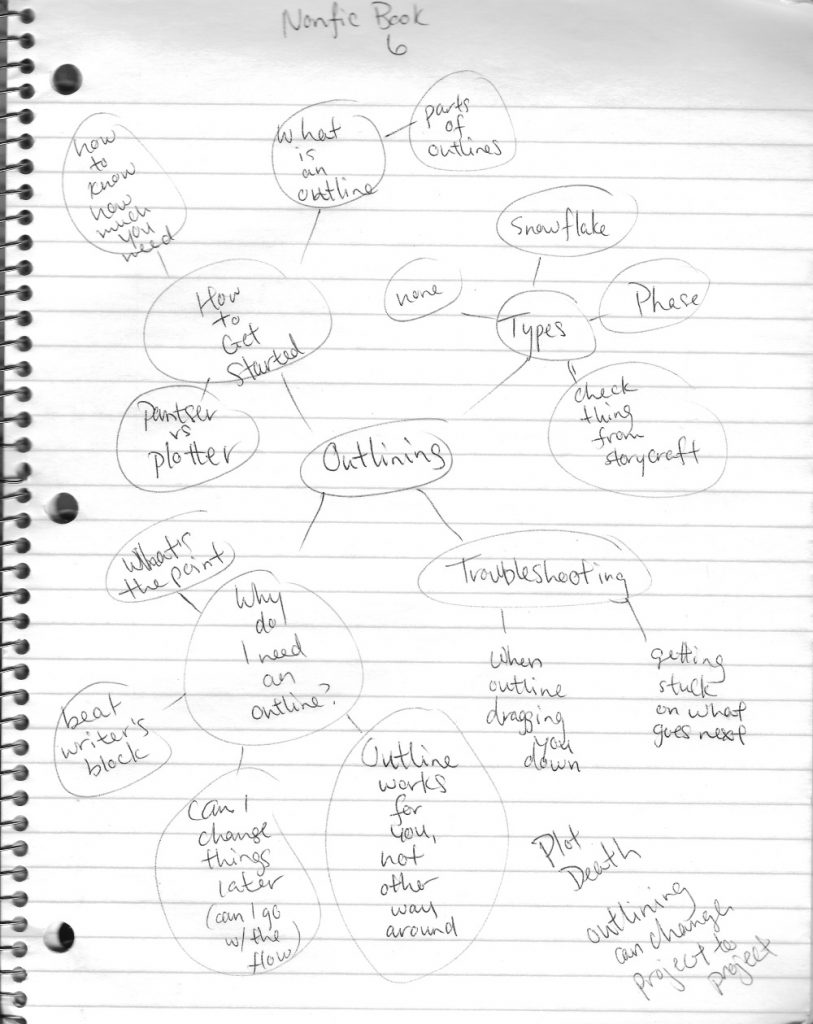All right, squiders! (Oh no, they’ve changed the blog interface and now I have to figure out where everything is again, argh.) Today we’re going to look at some basic forms of outlining (with examples) to give you an idea of how much (or how little) goes into an outline, and what one might look like.
Basic Outlines
A basic outline doesn’t contain much information. It mostly focuses on the bare minimum so that the author can get writing as quickly as possible, and often focuses on backstory and character development over plot and story arcs. Let’s look at some different types.
Premise
A premise outline isn’t really an outline, per se. But it is probably the most basic way to plan out your story. A lot of pantsers use this method. Basically, this where you have a basic idea for a story (with speculative fiction, a lot of times this is a premise—something like, what if time travel had been possible for millennia?—but it doesn’t have to be. Some people start with characters, a specific scene, a setting, whatever, and work from there). Knowing your idea, you play around with it until you feel like you have enough info to start (which varies per person) and then you start writing. Back when I pantsed, I tended to have a main character, a starting point, and a vague idea what the point of the story was.
Example:
I have an ancestor who was knighted by Queen Victoria—one of my Scottish ancestors—and I just think it would be fun to have him fight crime in Steampunk!London.
And then I might go on to do a basic character outline (Sir George Simpson, aged 46, respected doctor, likes tea, helping people, strolling about, does not like noise, technology, hoodlum. Add in a airship pirate character, female, who likes or is everything that Sir George hates, and maybe a rival physician). I would also do a vague plot (Sir George is called in to consult on a series of strange murders) and perhaps come up with a place to start (no reason not to jump straight in–Sir George comes home from one of his wanders to find a royal courier waiting). But again, this varies by person. But with this method, you basically have an idea and some other information, and off you go.
Freewrite
Freewriting is a technique where you just sit down and write without pre-planning what you’re writing about or thinking too hard about it while you’re doing it. The idea is to just let the words subconsciously flow from your fingers, and the idea is that sometimes you’ll get some really good stuff that was otherwise blocked from coming out in a normal manner. To use freewriting as an outlining technique, you just sit and write until you get something usable out of it. I often use freewriting to brainstorm story points and potential plot events if I get stuck on something I didn’t previously outline more in depth.
For example:
But what is the conspiracy? What are they hiding? If we assume that the year is somewhere in the near future, 2040s or something – which works actually, because it parallels the town pretending to be the 1940s – and Anna is a member of this society, she will have some disconnects between her surroundings and her subconscious memories. I also don’t know how old Anna is. I kind of want to put her at 18, because then she’s old enough to be able to think on her own, though it might be a little old if I want her to go to high school.
The idea with freewriting is that you let everything out, and hopefully in the process find what you need to start writing. It can be very helpful for figuring out your backstory and plot, as well as adding some depth and twists into your planning.
Mind Map
Mind mapping is a visual technique that works somewhat like freewriting, in that you don’t think too hard about what you’re doing and just follow the flow of your thoughts wherever they happen to go. It can be likened to a visual version of freewriting, but it can be very helpful in organizing a subject into topics. As an example, here’s the mind map for this very book:

We’ll look at additional types of outlines next week. Any questions on the basic types?
Oh, in addition, I’m trying out some new marketing. If you’d like to help me out, I’ve got a coupon for Hidden Worlds at Smashwords that makes it 99 cents. It should be a public coupon, so all you have to do is look at the book’s page for it to work. So if you like meta fantasy adventures and books on sale, there we are!



